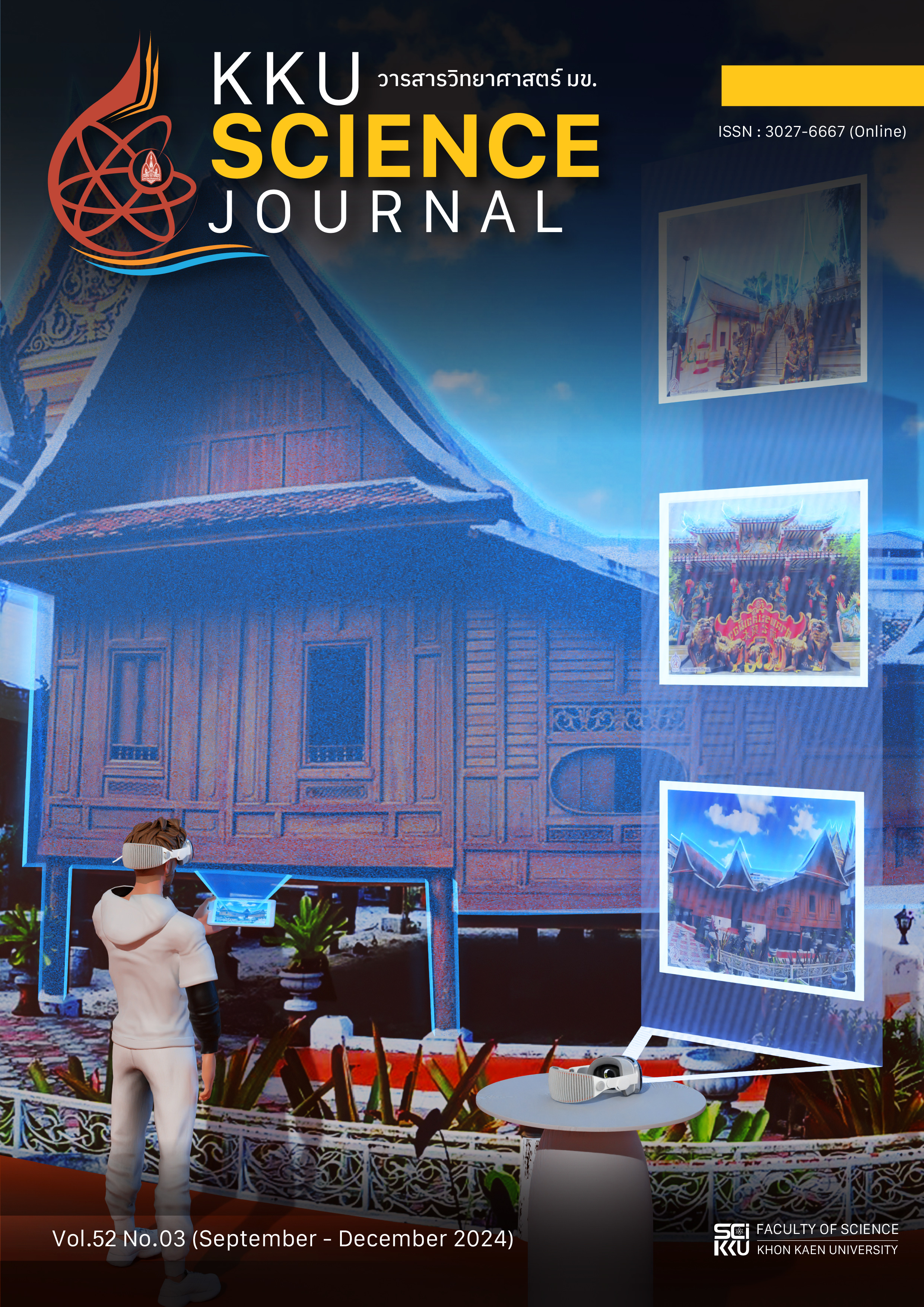The Analysis of Optimal Factors for Reducing Microbial Quantity in Dried Ganoderma lucidum using Factorial Design Experiment
Main Article Content
Abstract
The objective of this research was to investigate the optimal temperature and duration for microbial reduction in dried Ganoderma lucidum using a solar oven combined with electric heating coils. A 5x5 factorial experiment with three replications and a completely randomized design was performed. The factors studied included five temperature levels (40, 50, 60, 70, and 80ºC) and five drying time levels (4, 5, 6, 7, and 8 hours). The mean, standard deviation, factorial analysis of variance (ANOVA) with two components and the Kruskal-Wallis test were used to statistically examine the results. The total microbial count of bacteria, fungi, and yeast (CFU/g), moisture content (g/100 g), water activity (aw) and dry weight were found to decrease in all samples with increasing temperature and duration of drying time. With exception of aw, which did not exhibit any interaction, temperature and duration of drying time were found to have a significant effect on the total amount of microbial, moisture content, aw and dry weight. This was determined by variance analysis at a significance level of 0.05. It was concluded that the optimal temperature for drying G. lucidum was 70ºC for 8 hours, as it resulted in the total microbial count, moisture content, aw and dry weight of 2.70 x 103 ± 0.15 CFU/g, 1.20 x 102 ± 0.05 CFU/g, 7.30 ± 0.04 g/100 g, 0.78 ± 0.01, and 32.18 ± 0.03 g, respectively, These values conform with the microbiological quality standards for food and food contact surfaces and the community product standards (TIS 136/2015). These results suggest that this temperature is safe for consumers.
Article Details

This work is licensed under a Creative Commons Attribution-NonCommercial-NoDerivatives 4.0 International License.
References
กรมวิทยาศาสตร์การแพทย์. (2560). เกณฑ์คุณภาพทางจุลชีววิทยาของอาหารและภาชนะสัมผัสอาหาร. แหล่งข้อมูล: http://bqsf.dmsc.moph.go.th/bqsfWeb/wp-content/uploads/2017/Publish/e-book/micro-ISBN60.pdf. ค้นเมื่อวันที่ 19 เมษายน 2567.
จันจิรา อินทร์จันทร์. (2545). การอบแห้งเห็ดนางฟ้าด้วยเครื่องอบแห้งพลังงานแสงอาทิตย์แบบโมดุล. วิทยานิพนธ์วิทยาศาสตร์มหาบัณฑิต, คณะพลังงานและวัสดุ มหาวิทยาลัยเทคโนโลยีพระจอมเกล้าธนบุรี. กรุงเทพฯ. 62 หน้า.
นพมาศ สุนทรเจริญนนท์. (2552). รายงานการวิจัยการวิเคราะห์คุณภาพทางเคมีของสปอร์เห็ดหลินจือ (Chemical qualitative analysis of lingzhi spores). ใน: รายงานชุดโครงการวิจัยเห็ดหลินจือและสปอร์เห็ดหลินจือในประเทศไทย.
นวลจิตต์ เชาวกีรติพงศ์. (2545). หลักการถนอมอาหาร: การถนอมอาหาร. กรุงเทพฯ: สำนักพิมพ์ไทยวัฒนาพานิช. 9 - 21.
พิมพ์เพ็ญ พรเฉลิมพงศ์ และนิธิยา รัตนาปนนท์. (2553). Water activity / แอคติวิตีของน้ำ. แหล่งข้อมูล: https://www.foodnetworksolution.com/wiki/word/0551/water-activity-แอคติวิตี้ของน้ำ. ค้นเมื่อวันที่ 18 เมษายน 2567.
มหาวิทยาลัยแม่โจ้. (ม.ป.ป.). การเพาะเห็ดหลินจือ. ฐานเรียนรู้การผลิตเห็ดเศรษฐกิจ, สาขาพืชผัก, คณะผลิตกรรมการเกษตร มหาวิทยาลัยแม่โจ้. เชียงใหม่. 12 หน้า.
วิชญาพร เรืองธุระกิจ, ณปภัช พัฒนะถาวร และชยากร วงค์ภัคดี. (2558). การอบแห้งเห็ดนางฟ้าด้วยลมร้อน. ปริญญานิพนธ์วิศวกรรมศาสตรบัณฑิต, คณะวิศวกรรมศาสตร์ มหาวิทยาลัยบูรพา. ชลบุรี. 222 หน้า.
วิชมณี ยืนยงพุทธกา, กุลยา ลิ้มรุ่งเรืองรัตน์, ปณิดา ชัยปัน และต่อลาภ ศรีเมือง. (2560). ผลของอุณหภูมิและเวลาทำแห้งด้วยลมร้อนต่อคุณภาพของเห็ดเข็มทองผงที่ผลิตจากส่วนที่ไม่นิยมบริโภค. วารสารวิทยาศาสตร์และเทคโนโลยี 25(6): 1001 - 1014.
สำนักงานมาตรฐานผลิตภัณฑ์อุตสาหกรรมอาหาร. (2549). มาตรฐานผลิตภัณฑ์อุตสาหกรรมอาหาร: ผักและผลไม้อบแห้ง (มาตรฐาน มอ. 1234-2549). กรุงเทพฯ: สำนักงานมาตรฐานผลิตภัณฑ์อุตสาหกรรมอาหาร.
AOAC International. (2000). Official methods of analysis of AOAC International. Association of Analytical Communities.


